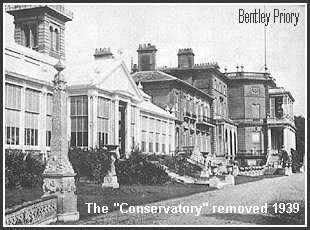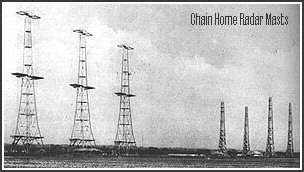| Document-16. |

Whenever we think of the Battle of Britain, our thoughts turn to Fighter
Command, if we thought of Fighter Command, our thoughts would then turn
to Air Chief Marshal Lord Hugh Dowding, and if we thought of Hugh Dowding
we would then think of the nerve centre of Fighter Command, Bentley Priory.
It was in July 1936, that during a complete reorganisation of the Royal Air Force, the task of creating an all new section fell to Air Marshal Sir Hugh Caswell Tremenhere Dowding KCB. This section was to be known as Fighter Command. Dowding had had an impeccable career that had originated in 1900 as an Army Subaltern with the Royal Garrison Artillery and it continued with the Royal Flying Corps during the First World War. He had commanded Fighting Area in the earlier Air Defence of Great Britain (ADGB) organisation in 1929-30 and thereafter for six years he was employed as Air Member for Research and Development on the Air Council. He was a man who had faith in the Radio Direction Finding(RDF) later to become known as Radar of which he had great influence on its future development. Dowding was a man of strong character with a mind capable of deep thought and foresight, and had very positive views on how his new Command and the air defence system should develop. He was of a naturally reserved nature with a disinclination towards most forms of socialising; his seemingly humourless, often grumpy image portrayed to those not of close acquaintance, plus a facility of quick acid comment, gave him enemies and a reputation for being difficult. He sought the favour of no-one. From his early service days the nickname 'Stuffy' endured. Dowding was given Bentley Priory as his headquarters. It was to be the nerve centre of Fighter Command. It was back in March 1926 that the Royal Air Force acquired a rather dilapidated house and land in Stanmore that is now known as Bentley Priory. On 26 May it became Headquarters of Inland Area that administered a number of air force home establishments and was under the command of Air Vice-marshal Tom Webb-Bowen CB, CMG. But before this, the 'Priory' had an interesting, yet chequered history. Originally, a rather insignificant small house that was owned by a Mr James Duberly it had been renovated, with the addition of many additional rooms that greatly increased its size, and became a highly prestigious country estate in the possession of The Hon James John Hamilton. In 1789 as 9th Earl and First Marquis of Abercorn, he engaged the services of architect Sir John Sloane to carry out massive extensions to the house and buildings at considerable cost. Later, it was owned by builder Sir John Kelp and when a Mr Frederick Gordon took over the elegant buildings and land it was turned into a luxurious private hotel. Before much of the property was sold off it had been used as a private boarding school for young ladies before the Royal Air Force acquired it in 1936.
Prior to moving into Bentley Priory, Dowding lived and conducted his
affairs from his home at Wimbledon Hill in the south west of London, and
it was from here that he outlined his plans for setting up an Operations
Room at the 'Priory'.
Dowding went to say that in the centre of the Ball Room would be the
main Operations Room Table that would be covered by a huge map that would
cover from Edinburgh in the north to the French coast, and from the border
of Wales in the west to the east of Belgium. A viewing gallery would be
required along the North and West sides of the Ball Room so that it would
be possible to observe the various movements that would be displayed on
the map below. Also, teleprinters would have to be installed, and these
would be placed in the Rotunda.
An intricate telephone and communication system would have to be installed. What was happening around the British coastline would be clearly displayed on the huge map that occupied the ballroom. Reports from the long-distance radar could possibly be received direct, and then relayed to the Groups Headquarters. Any Intelligence information would most certainly be received first at Bentley Priory and then circulated to groups and military offices. Finally, all movements of enemy and friendly bombers would be tracked and displayed on the map, but possibly for reasons of not making the map board to complicated and messy, friendly fighter movements would not be shown. A series of lights would be installed on one of the walls, and these would indicate as to the state of readiness of fighter groups.
 Leading
Aircraftman Jim Griffiths went on to say that as an LAC his weekly pay
was 31/6d of which a 10/6d of that was placed in a Post Office Savings
Account. He enjoyed life at Bentley Priory, and he had many memorable times
playing sports, the odd dance at the NAAFI and visits to theatres and pubs.
Occasionally he received weekend leave which he spent mostly with his parents
although he did have a good relationship with his girlfriend. At Bentley
Priory, he had his own room unlike other LAC's on station who had to live
a barrack room lifestyle, and the food at Bentley was absolutely first class.
There was an odd parade but there was also a lot of hard work that was
generally spread over long hours.
Work on the Experimental Operations Room was sufficiently advanced by
11th December 1939, that Dowding wrote to the Air Ministry requesting the
installation of GPO telephone lines. He also made mention of the intention
to limit the field of experiment to a single link up with No.11 (Fighter)
Group, and in so doing, concentrating effort in developing and proving
a prototype component of the future organisation.
Hugh Dowding in his role as Chairman of the Home Defence Committee's Sub Committee in May 1937, which was also the date of the creation of No.12 Fighter Group, gave a lecture to members of the RAF Staff College on "Fighter Command in Home Defence". and when we look at the basis of Dowding's lecture, we are to find that his ideas and opinions were remarkably prophetic. Hugh Dowding first spoke about how a war would be most quickly lost
and stated that this might possibly be caused by indiscriminate air attacks
on London and creating panic amongst its population. As an alternative,
an immediate paralysis of the food supply would have exactly the same
effect and that if the country could be secured against a quick decision
of this kind, then the only defeat could come from the slower process of
exhaustion of equipment, personnel, food, raw materials, sea transport and
other resources. He went on to state that the focal point of the machinery
of Government and the main centre for the distribution of the countries
food supplies would be London itself, and concluded that the most important
task would therefore be the defence of London itself. The most important
task therefore would be that defending London would be the most important
task in the defence of Great Britain. Dowding went on to say, that if he
was the dictator, then first and foremost, he would destroy the enemy's
Air Force at his airfields, reserve storage depots and factories etc.
Dowding had a strong interest in radar, he believed that radar was to be the eyes of Britain's defence system. It is understandable then, that it was of great importance to Dowding that he had direct communications with radar stations from Bentley Priory. Over the last few years radar had improved by research and by trials. Dowding had faith in radar. It was at Orfordness in 1935 that radar had expanded to such a degree that further accommodation was required. Land was purchased at Bawdsey Manor near Felixstowe on the Suffolk coast, and here although the research team was quite small, the quality, variety and inventiveness was remarkable. By April 1937, they were engaged in radar trials endeavouring to locate aircraft flying on pre-arranged courses over the North Sea. The results were said to be confused and disappointing and Dowding thought that the general standard of information was as yet unacceptable for his Operations Rooms. Nevertheless, by August the same year a plan for the construction of coastal radar stations had already been agreed.
 Each
of these would have four receiver masts that would be 250 feet high and
four transmitter masts with each one being 350 feet high. The reason for
duplication was their vulnerability to air attack, and the likelihood that
transmissions would be interfered with or 'jammed' by the Germans. In the
event of a mast or its aerials being damaged, or operating frequency being
impaired, there were others that were ready to take over. To improve results
they would be sited close enough together to form a chain where each station
oversaw part of its neighbours detection area.
In the photograph on the right, the transmitting masts can be seen on the left while the four on the right are the receiving masts that were constructed of wood to eliminate any stray reflections which may affect direction finding and height reading. Radar was in the hands of both civilian scientists and RAF Signals specialists, and after studying the results of the unsatisfactory trials in April 1937, Squadron Leader Raymond Hart was to become very influential in the study of radar operations. With other members of the team they agreed that if the radar stations were sited close enough together, then there would be an overlap in their fields of observation, which this would make it possible for every part of the coast to be watched. Although the technique made things complicated, it did require very careful handling and correlation of readings from two adjacent stations, but this method allowed the stations to be linked like a chain along the coastline. The system was approved by Dowding who, from early in the peace had great faith in radar and progress was being made with correlated information from the radar stations being relayed directly to the Bentley Priory Filter Rooms. Air Chief Marshal Hugh Dowding was to stay at Bentley Priory for the duration of the Battle of Britain and until he was relieved of his position as AOC Fighter Command. The 'Priory' was constantly in use throughout the rest of the war and today stands as a monument to the operations that were conducted there that finally led to victory in WWII. The Battle of Britain - 1940
website © Battle of Britain Historical Society
2007
|